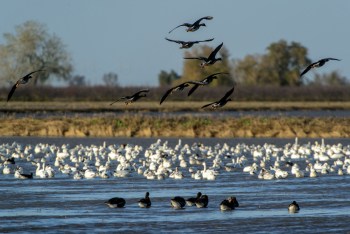
Migrating birds in California rice fields.
By Bryce Lundberg and Sean Doherty
Note – Rice farmer Bryce Lundberg serves on the California State Board of Food and Agriculture. Sean Doherty is a third-generation rice farmer in Dunnigan, Yolo County.
Last winter’s heavy rains were a welcome relief for Central Valley farmers after years of drought. But the high water that came with them also made it clear that we must upgrade the flood control system designed to protect people, farms and cities from catastrophic flooding.
Watching hurricanes Harvey, Irma and Maria from afar, Californians may not realize that our own Central Valley is at high risk of this type of flooding, especially as extreme weather events are becoming more common.
Fortunately, the Central Valley Flood Protection Board recently updated its plan to improve protection for farmers and city dwellers alike. It will also help revive flagging salmon runs and support other struggling native species.
As farmers, we are often on the front lines of California’s water challenges. We understand the benefits of wildlife-friendly agriculture. Rice farmers, especially, have taken the lead in finding ways to use limited water supplies to sustain farms while simultaneously benefiting birds, fish and other wildlife.
This multi-benefit approach to flood and water management is at the core of the new Central Valley Flood Protection Plan, which calls for building projects designed to allow rivers and floodplains to function more naturally. These projects come with additional public benefits, such as improving water quality, increasing groundwater recharge and providing outdoor recreation opportunities.
One of the best ways to both prevent flood damage and improve fish and wildlife populations is to find strategic places to expand floodways. Allowing flood waters to spread out and slow down lowers crests and reduces strain on the levees that line Central Valley rivers. And when rivers can safely handle higher flows, dam managers can keep reservoir levels higher during heavy rains, potentially increasing water supplies during the summer.
In addition to increased public safety, this approach seems much more promising for fish and wildlife than the current flow strategies. Instead of pitting the needs of wildlife against those of farmers, it focuses on ways to address both.
With the right approach, changing the way we manage floods could improve the survival of native fish without harming farms. If we help fish populations rebound by improving the health of our rivers, water allocations for farms and cities may also become more predictable.
The updated Central Valley Flood Protection Plan takes this right approach. Now it’s time for policymakers to ensure sufficient funding is available to turn the plan into action.


